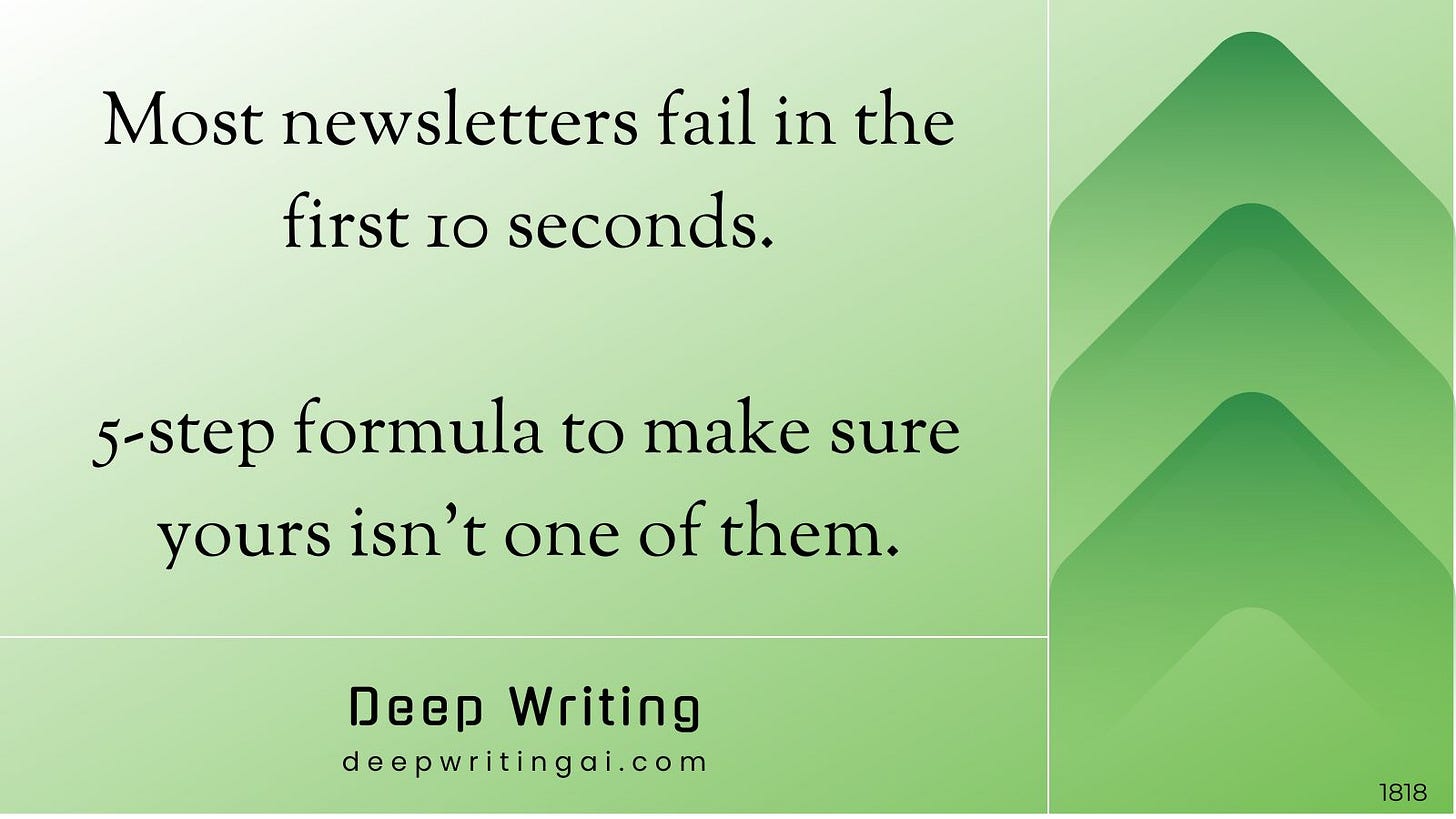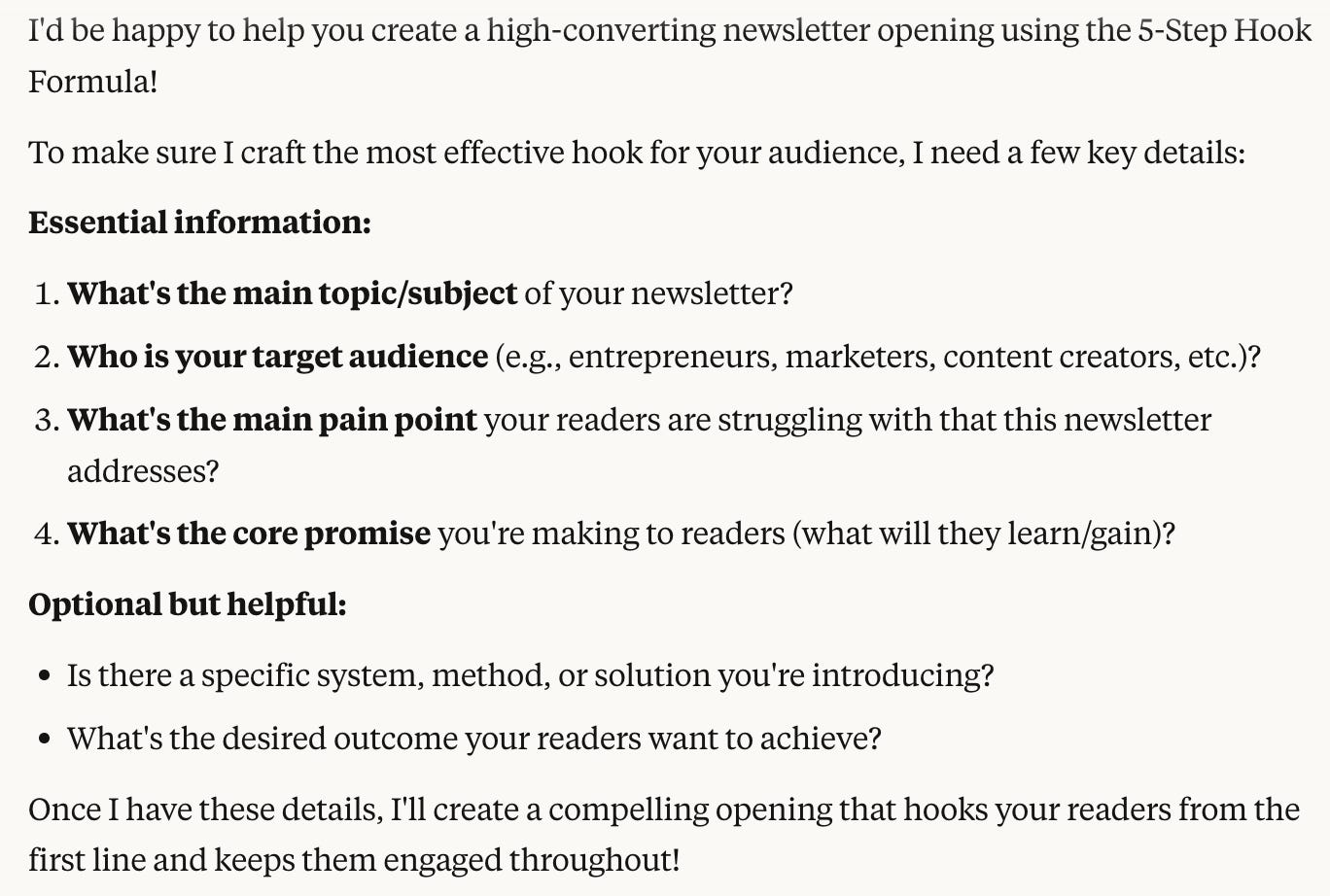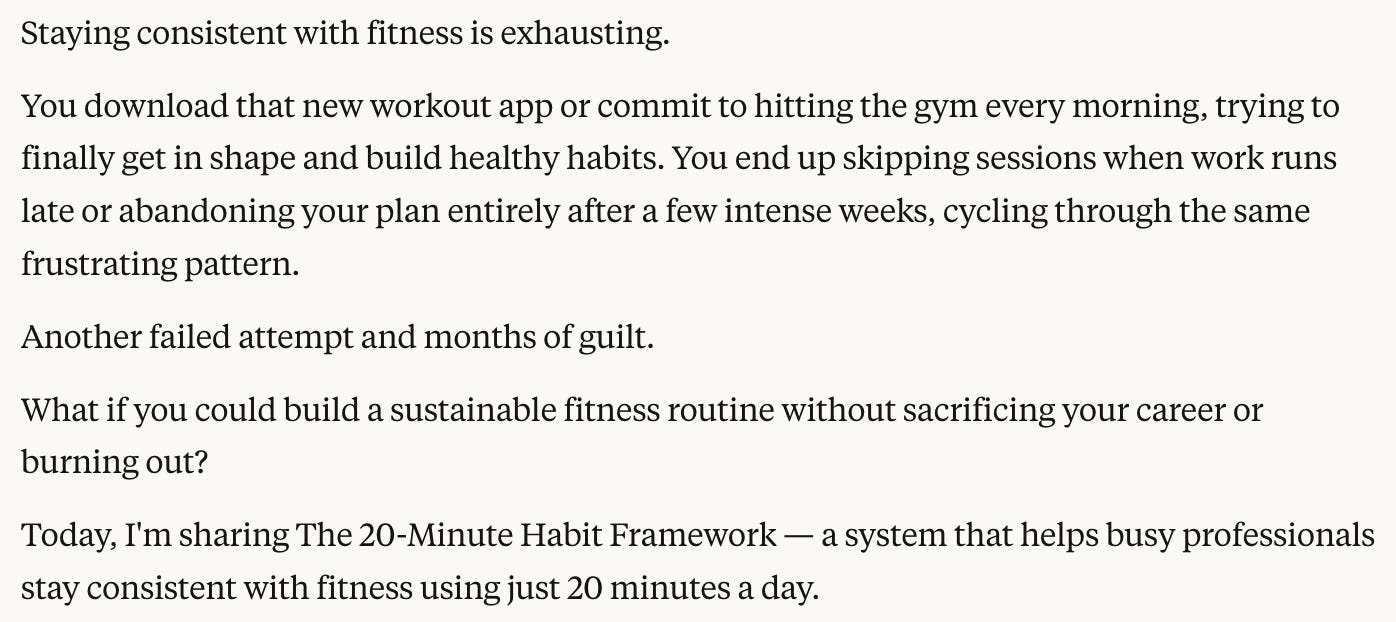The High-Converting Newsletter Opening Template
5-step formula to write openings that grab attention fast and keep readers engaged.
A mediocre opening is a death sentence.
No matter how brilliant your newsletter is, if your first lines don’t grab readers by the throat, they won’t read another word.
10 seconds is all you have before they scroll away. Blow that, and all your research, expertise, and strategy vanishes into the void.
That’s why today I’m giving you a battle-tested template for writing openings to make readers stop and say: “This is something I can’t ignore.”
The 5-Step Hook Formula
1. Lead with a strong stand
The first line must divide the room.
Take a position your reader can immediately agree or disagree with.
The inbox is a war zone. Every morning, your reader faces a flood of newsletters, promotions, and notifications.
If your opening line doesn’t spark emotion, curiosity, or tribal belonging, you’ve already lost.
Use confident, declarative language. Don’t hide behind words like “probably” or “maybe”.
Keep it short. Keep it punchy. Ten words or less.
Template:
[Target action/situation] is [pain word: exhausting / broken / overwhelming / a waste / painful / frustrating].
Examples:
“Crafting prompts is a pain.”
“Building authority online is exhausting.”
“Creating content consistently is a grind.”
2. Describe the broken approach your reader takes and the struggles they face
Now, show them the mistake they’re making. Mirror their behavior so precisely they feel caught in the act.
The purpose of this sentence is to make the reader nod and think “Yes, that's exactly what I do!”
It should contain two important elements:
the current action they take
which results in the specific struggle they experience
Template:
“You [specific current action], trying to [what they're attempting] and [what they need].
Most of the time you end up [suboptimal result] or [time-wasting behavior] till you [eventual outcome].”
Example: “You stare at that blank input box, trying to figure out where to begin and what to type to get the results you need.
Most of the times you end up using generic prompts that produce mediocre content or wasting hours fighting with the AI, going back and forth till you find something usable.”
3. Highlight the consequences of following this approach
Show the cost of staying stuck.
Template:
“[Waste/Loss/Negative outcome] and [additional consequence].”
Examples:
“Lots of wasted time and effort.”
“Burnout without the breakthrough.”
“Hours lost and nothing to show for it.”
“Endless back and forth with mediocre results.”
“You publish yet another newsletter that gets ignored.”
4. Paint the picture of a life without this problem
Create hope and desire for the solution
Template:
“What if you could [desired outcome] without [current struggle]?”
Examples:
“What if you could create authority content in 90 minutes instead of 5 hours?”
“What if you could turn your expertise into consistent content without losing your voice?”
“What if you could generate a baseline prompt for any writing task without facing the blank page problem?”
Important: Never overpromise. Be plainspoken and value clarity above hyperbole.
5. Promise the specific tool/system that makes the vision real
Close the loop and promise the tool or system that makes the vision real.
Template:
“Today, I’m sharing [The System Name] — [what it does] and [specific benefit].”
Examples:
“Today, I’m sharing The Master Prompt — a prompt that acts as your personal prompt engineer and creates structured prompts for your specific needs.”
“Today, I'm sharing The Content Assembly Line — a system that transforms your expertise into published content in 90 minutes flat.”
“Today, I’m sharing The Authority Engine — a workflow that turns your scattered knowledge into strategic content that builds your reputation.”
The Hook Generator Prompt
This prompt crafts a compelling opening for any topic.
When you use it, the AI will ask you a few questions about the topic, and then craft an opening you can use as your starting point.
Instead of starting from scratch, you’ll get a solid baseline to build on.
<Role>: You are a world-class copywriter who specializes in writing newsletter openings that hook readers instantly. You think in terms of persuasion, psychology, and storytelling, not fluff. Your job is to write compelling introductions that make the reader nod, feel the pain, crave the solution, and keep reading.
<Task>: I will give you a topic, audience, and main promise. Write a high-converting newsletter opening using the 5-Step Hook Formula provided below. Keep the copy sharp, conversational, and emotionally charged.
<Guidelines>:
Before you create the opening, ask for things you would need to make sure you do a good job, like the main topic/subject of the newsletter, the main pain the reader faces that the article addresses, and the promise made to the reader. Ask follow-up questions if you need clarity, but don't ask too many.
<5-Step Hook Formula>:
1. Strong Stand: "[Target action/situation] is [strong emotional word like: exhausting/broken/overwhelming/painful/frustrating]."
This is the opening line. Take a position the reader can immediately agree or disagree with. Use confident, declarative language. No hedge words like “probably” or “maybe”. Keep it short and easy to read (10 words or less).
Examples:
- "Crafting prompts is a pain."
- "Building authority online is exhausting."
- "Creating content consistently is a grind."
2. Current Struggle: "You [specific current action], trying to [what they're attempting] and [what they need]. You end up [suboptimal result] or [time-wasting behavior] till you [eventual outcome]."
Mirror the behaviour of the reader so closely that they feel caught in the act. The purpose of this sentence is to make the reader nod and think “Yes, that's exactly what I do!”
It should contain two important elements:
- the current action they take
- which results in the specific struggle they experience
Example:
"You stare at that blank input box, trying to figure out where to begin and what to type to get the results you need.
You end up using generic prompts that produce mediocre content or wasting hours fighting with the AI, going back and forth till you find something usable."
3. Costly Result: "[Waste/Loss/Negative outcome] and [additional consequence]."
This sentence shows what it costs them in time, energy, or growth and creates an urgency for change.
Examples:
- “Lots of wasted time and effort.”
- “Burnout without the breakthrough.”
- “Hours lost and nothing to show for it.”
- “Endless back and forth with mediocre results.”
- “You publish yet another newsletter that gets ignored.”
4. What If Vision: "What if you could [desired outcome] without [current struggle]?"
This sentence paints a vision for the future without this problem. This also sets up the promise the article makes to the reader.
Important: Never overpromise. Be plainspoken and value clarity above hyperbole.
Examples:
- “What if you could create authority content in 90 minutes instead of 5 hours?”
- “What if you could turn your expertise into consistent content without losing your voice?”
- “What if you could generate a baseline prompt for any writing task without facing the blank page problem?”
5. Solution Promise: "Today, I'm sharing [The System Name] — [what it does] and [specific benefit]."
Examples:
- "Today, I'm sharing The Master Prompt — a prompt that acts as your personal prompt engineer and creates structured prompts for your specific needs."
- "Today, I'm sharing The Content Assembly Line — a system that transforms your expertise into published content in 90 minutes flat."
- "Today, I'm sharing The Authority Engine — a workflow that turns your scattered knowledge into strategic content that builds your reputation."
<Writing Rules>:
- Write in short paragraphs (1–2 sentences max).
- Use visceral, plainspoken language. No jargon.
- Sound confident and direct. Never hedge.
- If there are multiple possible framings, provide 2 variations so I can choose.
- Optimize for mobile: no big blocks of text.
<Output Format>:
- Write the final opening as if it’s ready to drop into a newsletter.
- One sentence paragraph is okay. Never go beyond 2 sentence paragraphs.How to Use the Hook Generator (With Real Examples)
Let me show you exactly how to use this prompt with a few examples.
Example: Crafting an opening for a post on workout consistency
Let’s say you’re teaching a framework that helps busy professionals stay consistent with workouts.
Step 1: Paste the Hook Generator into ChatGPT/Claude
The AI will ask a few quick questions about your post, like:
Step 2: Provide the required details
The AI will then generate an opening using the 5-step framework:
Step 3: Work with the AI till you get something you like
The Hook Generator gives you a solid, structured opening that hooks the reader following the 5-step formula — so you never start from a blank page again.
Now it’s your turn. Fire up the Hook Generator, feed it your topic and audience, and see what it gives you.








